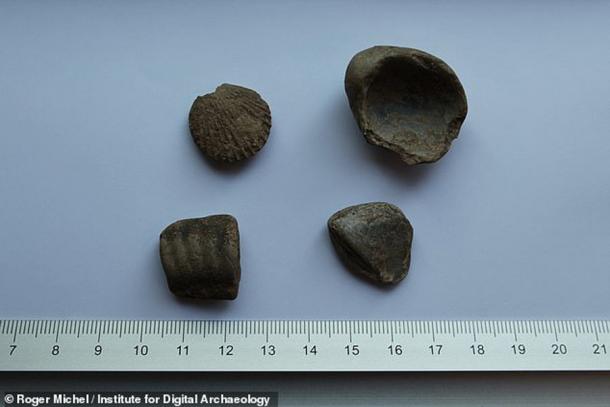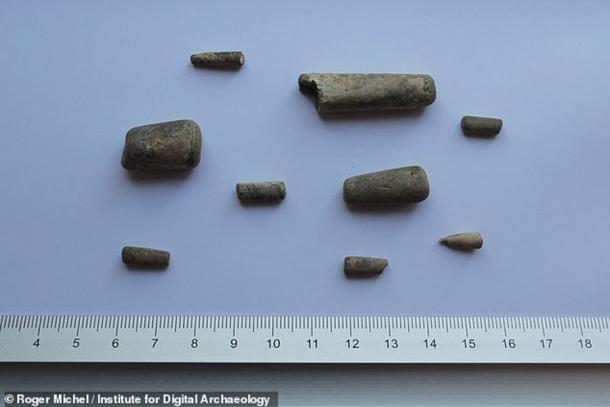
Neanderthal Camp Discovered at Princess Diana’s Althorp House Estate
At Althorp House, the stately home on the late Princess Diana’s family estate northwest of central London, excavations have led archaeologists to suspect that its known history may be predated by some tens of thousands of years! The archaeologists were hunting for the remains of an abandoned medieval village when they came across worked seashell pieces from a far older Neanderthal camp, dating back at least 40,000 years.

Pieces of worked seashell found at Althorp House, in Northamptonshire, England, were carbon dated and proven to be more than 40,000 years old. (Roger Michel / Institute for Digital Archaeology)
From Neanderthal Camp to Olletorp Village to Althorp House
The Telegraph reports archaeologists were hoping to find the site of the medieval village of Olletorp that had been abandoned following the devastating medieval plague, the Black Death, in the 14th century. They were following the hunch of the late Earl of Spencer, Lady Diana’s father, who believed it to lie 1000 yards (914 meters) west of Althorp House, the imposing Spencer home built in 1688.
Records of Olletorp appear in the Domesday Book, the manuscript of the “Great Survey” of much of England and parts of Wales ordered in 1086 by William I, also known as William the Conqueror. Olletorp had disappeared by the time Lady Diana’s wool baron ancestor bought the estate in 1508. It has been the Spencer family’s estate since then.
- 14,500-Year-Old Stone Engravings: Archaeologists Uncover Earliest Known Art in Britain
- Skull Cups and Chewed Bones: Cannibalism was Ritual Behavior during Stone Age say Researchers
Archaeologists from the Institute for Digital Archaeology (IDA) have been surveying Lady Diana’s childhood home for the past year. The team dug pits and trenches, used ground-penetrating radar technology, and took more than hundred samples from the site. Recently, a BBC film crew filmed the excavation process.

Though evidence of the medieval village of Olletorp have yet to be found, archaeologists did find an pieces of prehistoric worked antler at the Althorp estate. (Roger Michel / Institute for Digital Archaeology)
The Neanderthal Past of the Althorp Estate
According to The Telegraph, the IDA’s Executive Director Roger Michel, an Oxford University classmate of Charles Spencer the present Earl and Lady Diana’s brother, stated they had uncovered evidence of a settlement from the Palaeolithic Period (3.3 million to 11,650 years ago) that was probably home to a group of Neanderthals.
Carbon dating of the carved seashells recovered from the site revealed that they are at least 40,000 years old. This makes it one of the oldest settlements found so far in Britain. Based on the carbon dating results, stately Althorp House was home to the Neanderthals 40,000 years ago.
The Neanderthals are known to have been in Britain as early as 400,000 years ago. There is archaeological evidence to show that as glaciers alternately advanced and retreated between ice ages, the Neanderthals returned to Britain around 30,000 to 50,000 years ago.
Roughly 40,000 years ago, modern humans began arriving in Britain. The Althorp discovery thus dates to a time when Britain was home to two different species of humans, and around the time the Neanderthals were about to go extinct.
The seashell fragments were found in a prehistoric rubbish midden that also contained antler chips and flints, which indicates it was a Palaeolithic tool-making site. IDA’s Roger Michel said, “We don’t think the shells would have been the remnants of a prehistoric meal as Althorp was even further from the sea then than it is today. They are also incised. They could have been used for decoration or as spurs of mother of pearl for jewellery.”

Neanderthals cooking animal meat around a fire, which was likely the scene at Althorp House 40,000 years ago. (Gorodenkoff / Adobe Stock)
The Neanderthals in Britain
According to the UK’s Natural History Museum, Britain is known to have been home to four different species of humans. Neanderthal sites have been found in Britain from 400,000 years ago to around 30,000 years ago. In that time, they were beaten back several times as the climate became too harsh for them to survive. Between 180,000 years ago and 50,000 years ago, there is no evidence of any Neanderthal settlement in Britain, although they were to be found elsewhere in Europe in that period.
Once the recent discovery is verified, Althorp House will be added to Britain’s Neanderthal site list.
- Ancient Human Smile Used as an Effective ‘Get-Sex’ Tool
- Five Surprising Things DNA has Revealed About our Ancestors
The finding of the Neanderthal artifacts, however, isn’t the end of the story as far as Olletorp is concerned. As Roger Michel said, “We still hope to find Olletorp for Charles. Our geophysical surveys of the site reveal many areas of interest that merit further exploration. Althorp may very well tell the entire story of the settlement of Britain from the time of the earliest human habitations straight through to the HS2 that will pass not far from the estate.”
The HS2, for non-British readers, is a new high-speed railway project in the UK linking up London, the Midlands, northern England, and Scotland.
Top image: England’s Althorp House, Lady Diana’s family home, is the center of a huge estate on which archaeologists discovered a 40,000-year-old Neanderthal camp. Source: Steve Daniels / The rear of Althorp House / CC BY-SA 2.0
By Sahir Pandey
References
de Bruxelles, S. 2021 . Princess Diana’s childhood home was early Neanderthal camp, archaeologists believe. Available at: https://www.telegraph.co.uk/news/2021/10/10/princess-dianas-childhood-home-early-neanderthal-camp-archaeologists/
Hendry, L. The First Britons. Available at: https://www.nhm.ac.uk/discover/first-britons.html















